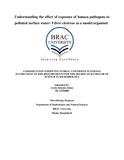Understanding the effect of exposure of human pathogens to polluted surface water: Vibrio cholerae as a model organism

View/
Date
2018Publisher
BRAC UniversityAuthor
Islam, Syeda SumaiyaMetadata
Show full item recordAbstract
Urbanization and industrialization results in the fecal organisms contaminating the water-bodies which are important sources of recreational activities. This eventually increases the risk of humans getting infected during accidental ingestion or contact. The purpose of the study was to detect the presence of Vibrio cholerae in water bodies contaminated with industrial pollutants. For this purpose Hatirjheel Lake and Buriganga River, the two prominent water bodies of our country were chosen for sampling. A total of 40 samples were collected aseptically from Hatirjheel Lake and 20 samples from Buriganga River within duration of three months. Then, they were processed for isolation of culturable Vibrio cholerae. After that several biochemical tests were done for presumptive identification of isolates. For further confirmation, RT-PCR was done targeting CqsS gene. While many isolates were found to be positive with biochemical tests, after RT-PCR only 5% of samples from both water bodies gave positive result. Further, three strains from both water bodies were tested for survival potential under starvation stress. The survival patterns between the lake and river showed slight difference but both showed a gradual decrease in culturable count over the time. Next, the strains from those water bodies were checked for their susceptibility to an array of eight antibiotics. The antibiogram revealed that isolates from Hatirjheel showed complete resistance to tetracycline, ampicillin, ceftriaxone while the Buriganga isolates showed complete resistance to only ampicillin, tetracycline, nalidixic acid, co-trimethoprim and ceftriaxone. While no conclusion could be drawn on the actual presence of Vibrio cholerae in Hatirjheel or Buriganga, isolation of this organism from heavily polluted water bodies could be difficult.
